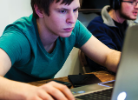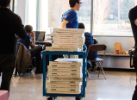Feature
The Big Hack
Inside UB’s not-so-secret hacker community

Student hackers hard at work in the lobby of Davis Hall.

Rohan Shah
Major League Hacking
Thanks to Rohan Shah, Nate Burgers and others, UB currently ranks 23rd nationally in student hacking. Rankings are determined by points given for attendance and merit. Check back here for updated standings.
Within this story:
Story by Julie Wesolowski & Photographs by Ariel Namoca

THE LOBBY OF DAVIS HALL on UB’s North Campus looks like a makeshift computer center filled with folding tables, power strips and a tangled mess of electrical cords. Teams of student hackers barely take focus from their laptops and mobile device screens while talking in hushed voices about their hacking plans. It’s only 30 minutes into UB Hacking, a 24-hour student hackathon, and concentration in the room is almost palpable.
But wait, aren’t hackers bad guys? Not exactly. Unlike what’s portrayed on TV, hackers generally aren’t nefarious cyber geniuses creating malicious computer programs that invade our PCs and tap into our private information. (That’s another story—see “Hacking a Course.”) Rather, most hackers are merely putting their skills to use in an unprecedented way. Nearly anything, whether it’s a computer program, a mobile game or even a musical instrument, can be adapted or changed with an idea and some skill. And the resulting product, whether it’s a tangible object or a novel digital application, is called a hack.
At hackathons, including the one held at UB, groups of hackers (typically computer programmers, designers and developers, but it’s never limited to those skill sets) get together for a designated amount of time, share ideas and collaborate on a project. Sometimes hackathons are for the benefit of a humanitarian cause, aimed at creating an application or product to solve a real-life problem or issue. Other times they are competitions pitting hacker against hacker, or hacking team against hacking team, in a judged competition for money and/or prizes, free food and T-shirts, in addition to bragging rights and major cred among fellow hackers.
With a never-ending supply of students armed with fresh ideas, coding skills and programming know-how, college campuses across the country and around the world are a breeding ground for hackers, and often serve as a tightly knit network of support. UB has been right in there, cultivating its own community of hotshot hackers.

UB Hackathon sponsors and organizers gather around Nate Burgers for a closer look at the progress on his hack.
One of UB’s fiercest competitors is Rohan Shah. A computer science junior with a minor in business, Shah has entered only three hackathons, but they were big ones. Amazingly, he won in his chosen category at all three—including the world’s largest hackathon, MHacks, at the University of Michigan in Ann Arbor. He also won first place at Purdue University’s prehack, which gained him a spot at the BoilerMake hackathon. At the latter, he won the iOS App award from Apple, despite a travel situation that would likely have unnerved a less focused competitor. “I took the bus from Buffalo to Purdue University, traveling almost 12 hours just to compete,” he recalls. “The event started within one hour of my arrival.”
Watch Video
Lark - An Interpreted Language for Objective-C
Computer science junior Nate Burgers has placed in the top 10 at five or six hackathons. “At this point I can’t keep track of them all,” he says. “I’ve been to at least a dozen, plus or minus three.” His proudest hack lives on as a solo project today. In the course of the 48-hour hackathon MHacks, Burgers created a programming language called Lark that lets iPhone and iPad app developers edit applications without having to rebuild the entire program from scratch. With Lark, Burgers placed in the top 10 out of 1,200 competitors, and took home $2,000 for “Most Technically Impressive” hack. He’s now considering making his Lark hack into a business.
According to Burgers, a lot of the skills hackers use at hackathons are self-taught. And while it is typically a competition, the camaraderie among hackers runs deep. “We celebrate each other’s successes and joke around constantly,” he says. “The premise of hackathons is to have fun building things with your friends.”
UB’s 24-Hour Hackathon: The Good, the Bad and the Ugly
Using a combination of above-average wits and a youthful ability to stay awake for an extended period of time, 70 students participated this past April in an all-night marathon of technical skill and problem solving in UB’s Davis Hall.

Piles of pizza were consumed, mountains of Mexican food munched and late-night snacks washed down with gallons of highly caffeinated beverages. Teams gathered steam or spiraled into despair. Some hackers attempted to grab a few moments of sleep on cramped lobby sofas while others killed the monotony through random hijinks.
Some teams never made it to the morning, self-destructing as the night progressed. Others rallied as the sun began to rise. As the last few hours ticked away, final tweaks and tests were implemented. Bleary-eyed and unwashed, hackers appeared to be running on fumes as they assembled to present their hacks to their peers.
Twenty-four hours after it began, 13 hacks were demo’d. Some elicited awe, others laughter and yet others sympathy. All were given a rousing round of applause for effort.
And the winners were….

1ST PLACE
Redtooth
Nate Burgers
According to Burgers the actual hack is pretty complicated. Simply put, he says, “It makes all the iPhones and iPads in a room connect to each other and act like one big supercomputer.”

2ND PLACE
AGNEW Secure Shelf
Garrett DeFilipps, Kevin Rushlow
Their catch phrase was “Check Your Shelf Before You Wreck Your Shelf.” If a book is removed from the smart shelf without the passcode, an alarm is triggered and an alert sent to an email address or phone.

3RD PLACE
Let’s Get Flappy
Andrew Hughes, Anand Nandugudi, Nils Wisiol
The multiplayer version of the popular online game Flappy Birds gives users the ability to join the game using personal devices, such as smartphones.
Additional Awards:

MOST OUTRAGEOUS HACK
Awesome Guitar
Joe Materski, Tomasz Pietruszka, Kyle Thompson, Scott Will
The plan was to integrate a guitar with a computer program, which would write the music as it was played. An ambitious hack the team wasn’t able to finish within 24 hours.

BEST MOBILE HACK
Monorail Madness
Ronnie Bar-Kochba, Evan Slimak
This online game follows monorail cat on his mission to complete a journey during the apocalypse.
Meet Joe Peacock
Student hacker/CTO

Joe Peacock, right, giving advice at the UB hackathon.
We’ve all heard a version of this story by now—tech-savvy college student creates an Internet start-up, quits school and becomes a huge success. Current UB computer engineering junior Joe Peacock is following that path, with one difference: He aims to achieve his dreams with degree in hand. As co-founder and chief technology officer of start-up Gradfly, he’s balancing coursework with client meetings while managing a team of four engineers, all UB graduates.
Peacock’s company created a project documentation and collaboration tool for STEM (Science, Technology, Engineering and Math) students that helps potential employers find a good match in prospective employees. As one of the sponsors of UB’s hackathon (other sponsors included Facebook and Bloomberg), Peacock had the distinction of being the only teenage CTO giving hackers advice in the room.
Prior to Gradfly, Peacock was making a name for himself at hackathons, most notably placing second at a Princeton University hackathon and at Startup Weekend Buffalo, as well as winning Hack Upstate in Syracuse. According to Peacock, attending those hackathons helped him grow as a developer. “If it hadn’t been for all of the time I spent working on projects at hackathons, I would not be anywhere near where I am now,” he says.
Ultimately Peacock hopes that Gradfly, which employs seven people in addition to himself, will connect students with good jobs in Buffalo, including more positions within his company. “Watching the tech industry explode in places like Silicon Valley, New York City and Boston is so exciting. I would love to be a part of making that happen right in my backyard,” he says.
Hacking a Course
Molding UB’s next generation of cyber security experts

UB’s first-ever Cyber Security Competition pitted undergraduate student teams against graduate students in a real-time hacking simulation.
THE OTHER TYPE OF HACKERS, the bad ones, are still out there. And they are attempting to steal our identities and threaten our cyber security every second of every day.
Some industrious UB students are learning how to combat the ill-intentioned hackers through unique study of the topic, guided by three UB alums. While the university offers a graduate-level program in cyber security and information assurance—with a National Science Foundation Scholarship for Service (NSF SFS) grant—a similar curriculum for undergraduates doesn’t exist. So Chris Crawford (MS ’09, BS ’07), together with Management Information Systems (MIS) adjunct professor David Murray (MBA ’97, BS ’97) and Computer Science (CS) lecturer Kevin P. Cleary (MBA ’05, BS ’03), hacked together a solution with the Network Defense independent study.
The guided course mixes an official class with free-form independent study, bringing undergraduate and graduate students together in one room. The students are a blend of CS majors, who primarily work with programming languages, and MIS majors, who determine how to use technology environments to solve problems. The area where their studies overlap is the cyber security sweet spot.
The class also serves as a feeder for the master’s program in information assurance, enticing students to enroll in the NSF SFS program where, in exchange for scholarship assistance, they promise to work for the federal government after graduation.

Crawford, a D.C. resident and contractor with the U.S. Department of Defense and the Department of Homeland Security, was the driving force behind the independent study class and does much of the lecturing remotely. “After I got some experience, I started thinking about how I could channel what I had learned in the real world back to students at UB,” he explains.
According to Murray, “It’s one of the most organic learning experiences I’ve ever been involved with.” Spring semester’s final project was the first-ever UB Cyber Security Competition, which was designed and implemented by the students. The timed competition simulated real-time security breaches, utilizing graduate students as the hackers and undergraduates as the cyber security specialists trying to prevent and fix the breaches.
Like hackathons, cyber security competitions are becoming more widespread, popping up at universities across the country. At Alfred University’s 2013 competition, hotshot hacker Rohan Shah led one UB team to second place while another UB team came in first.
Julie Wesolowski is a Buffalo-based writer and digital communications professional.














